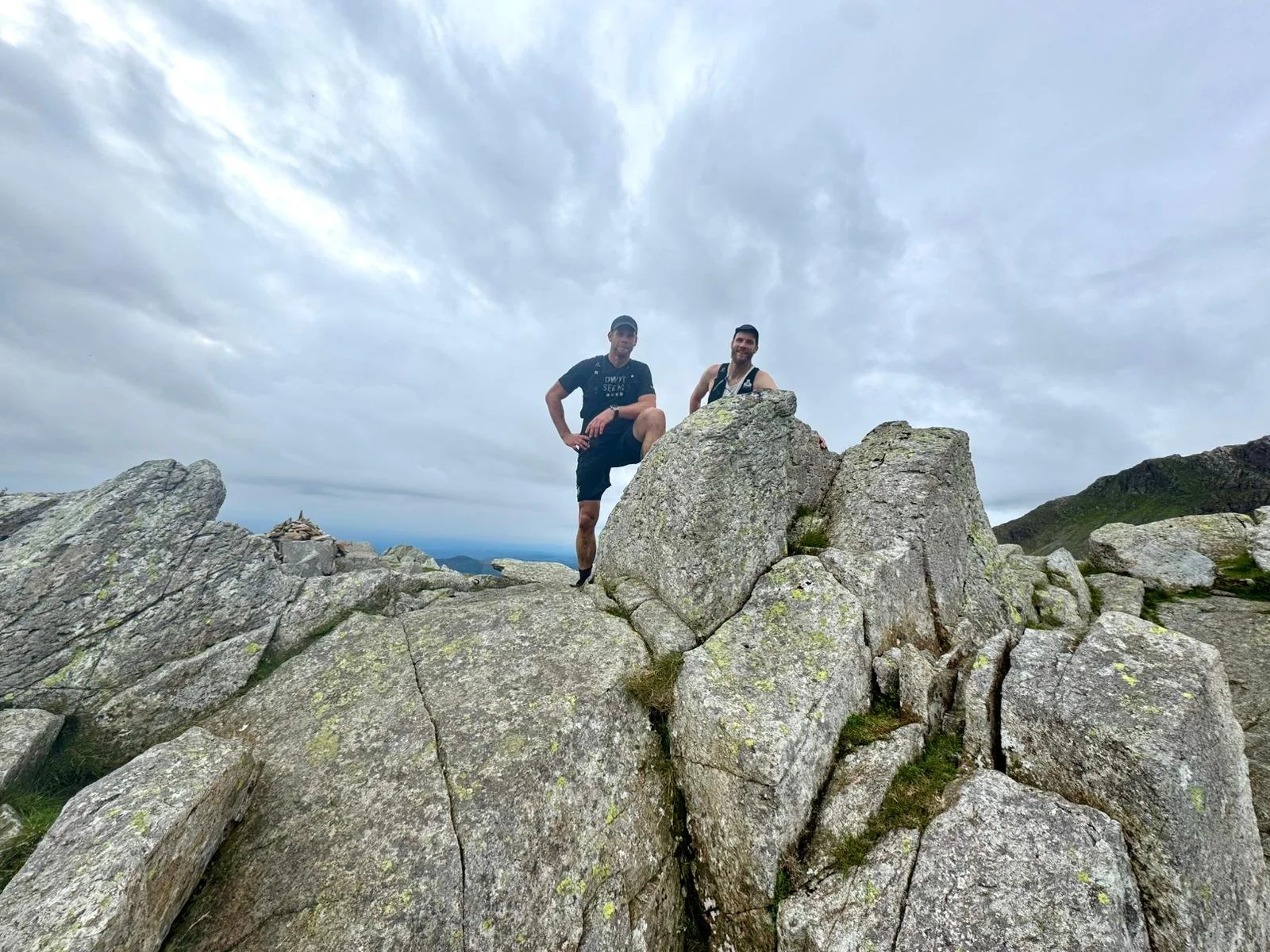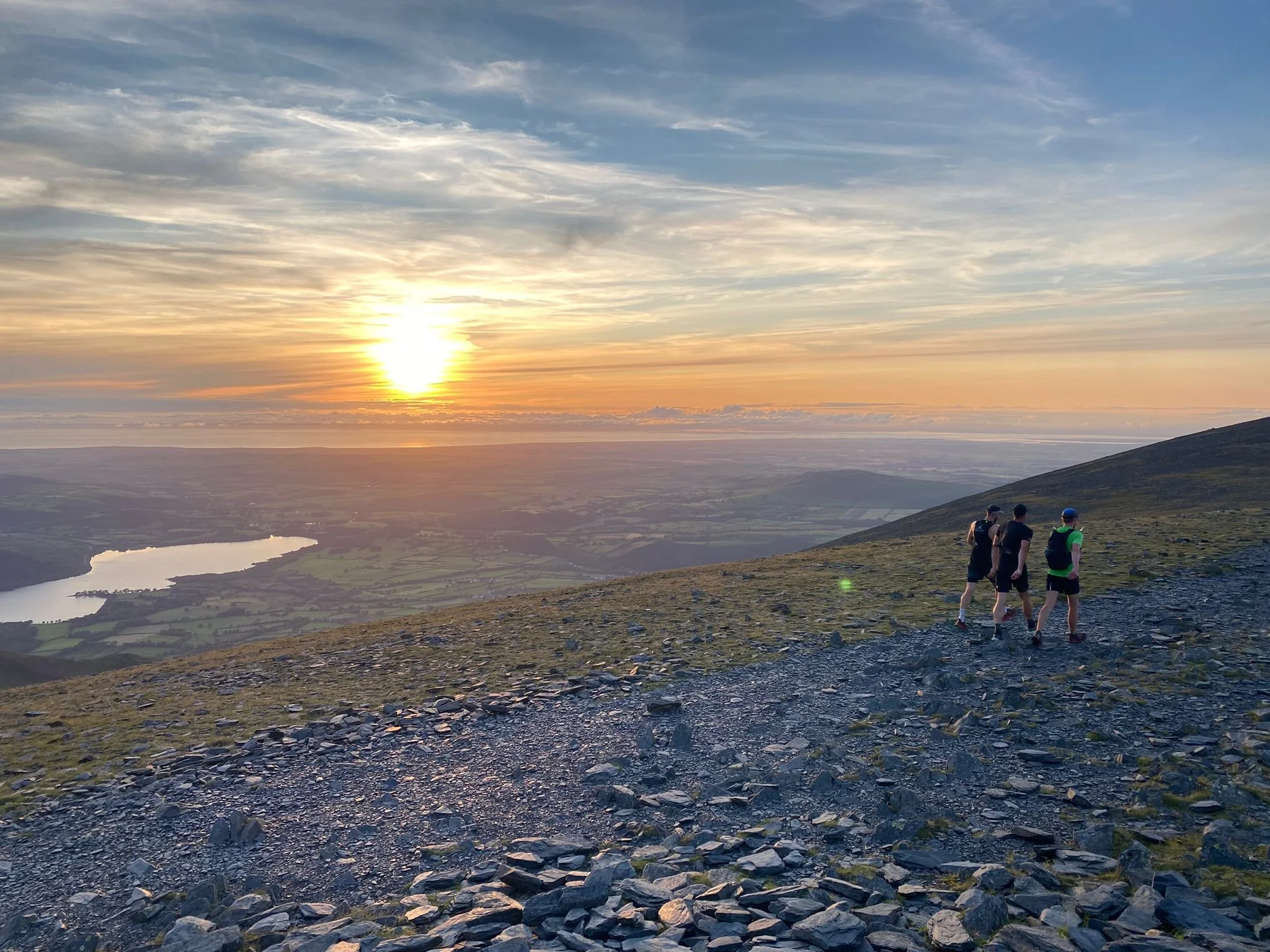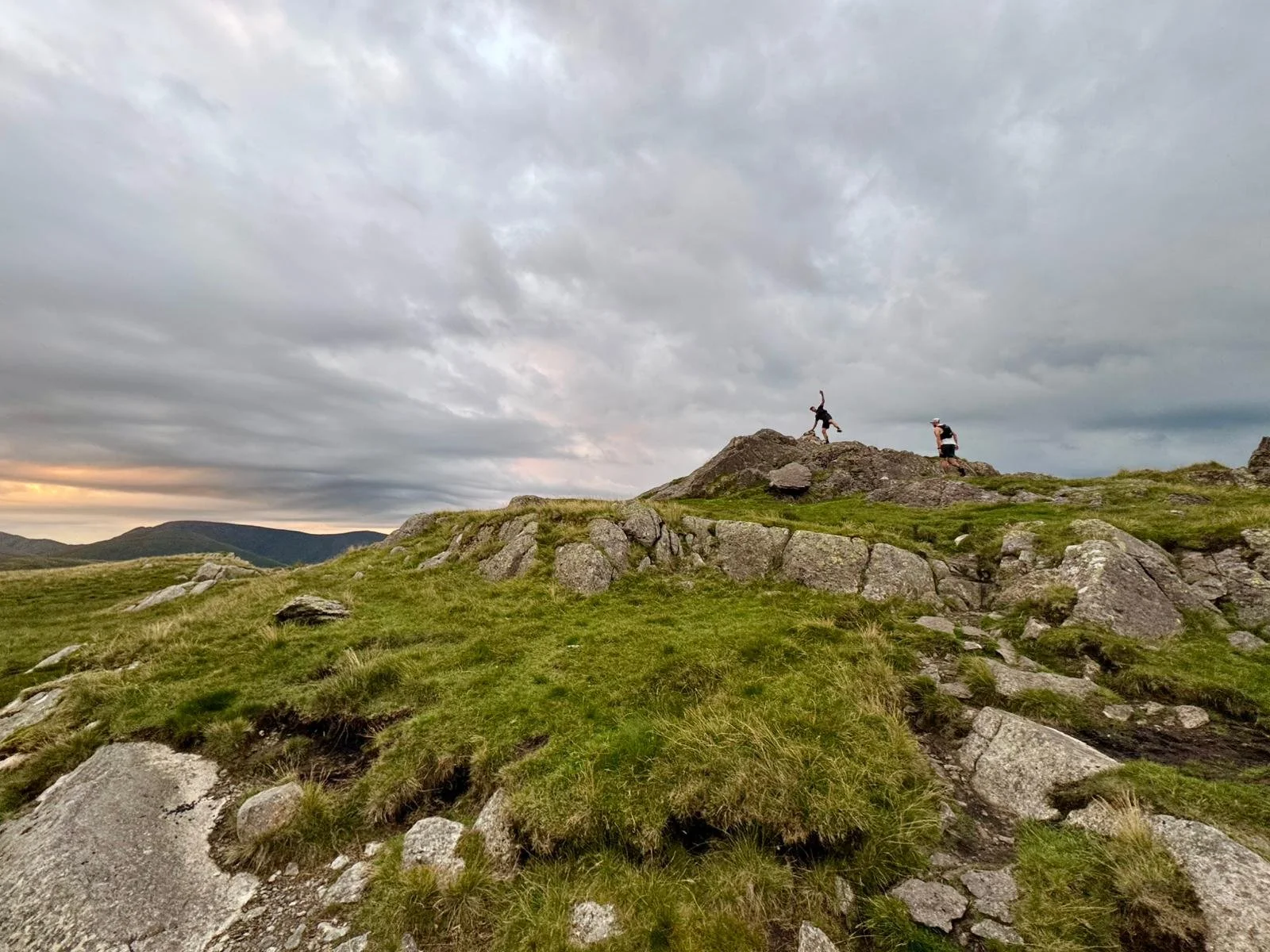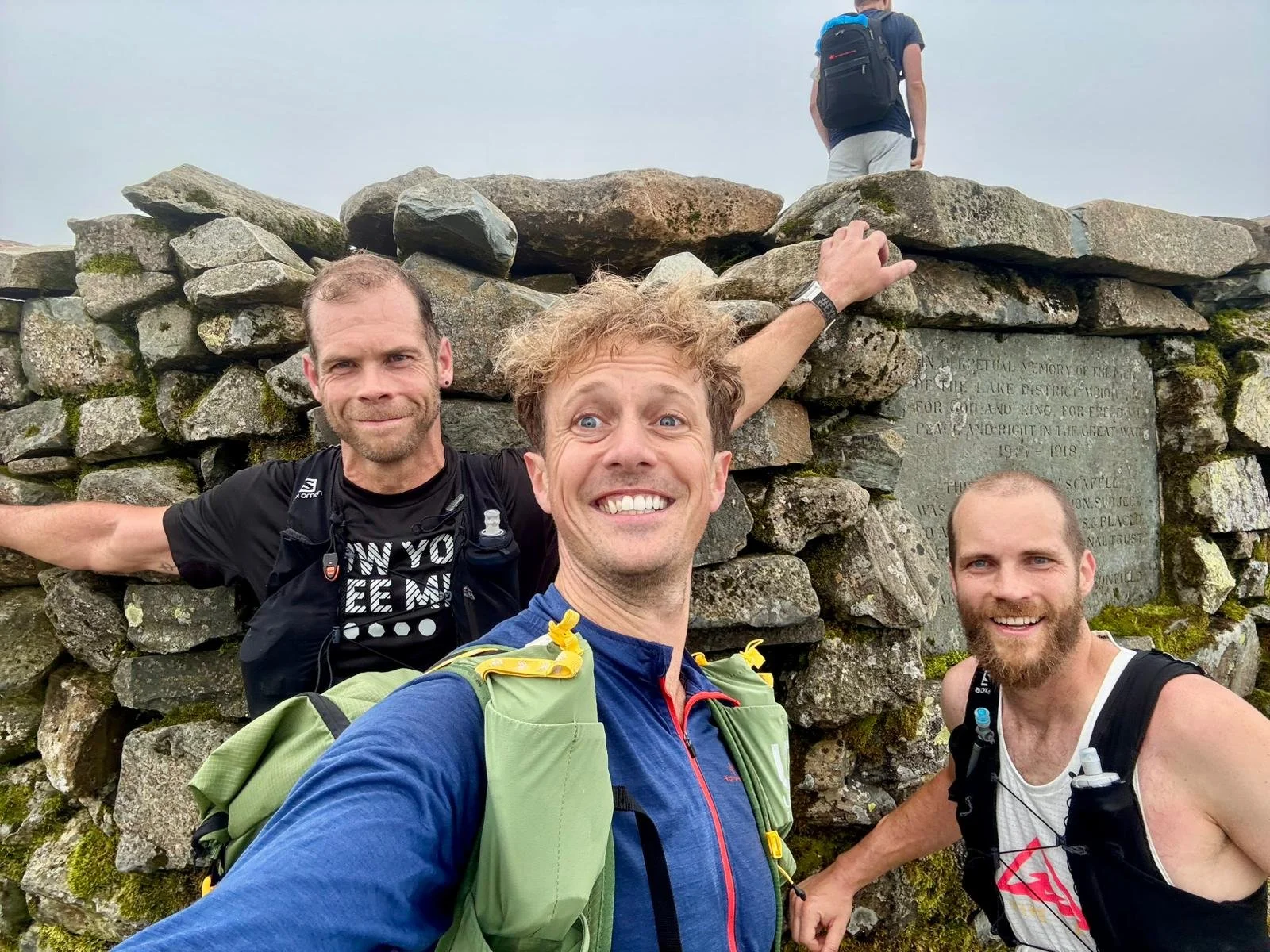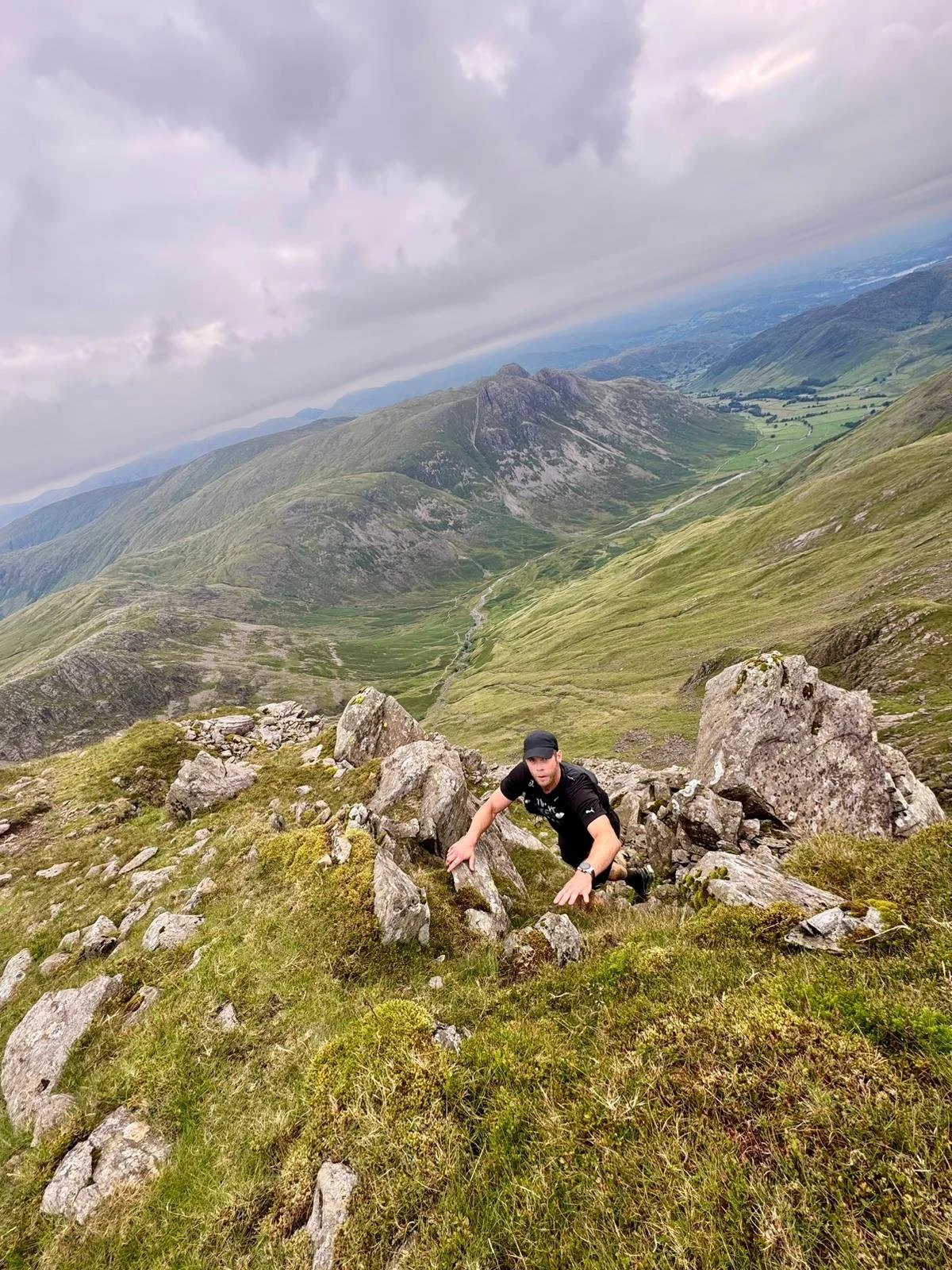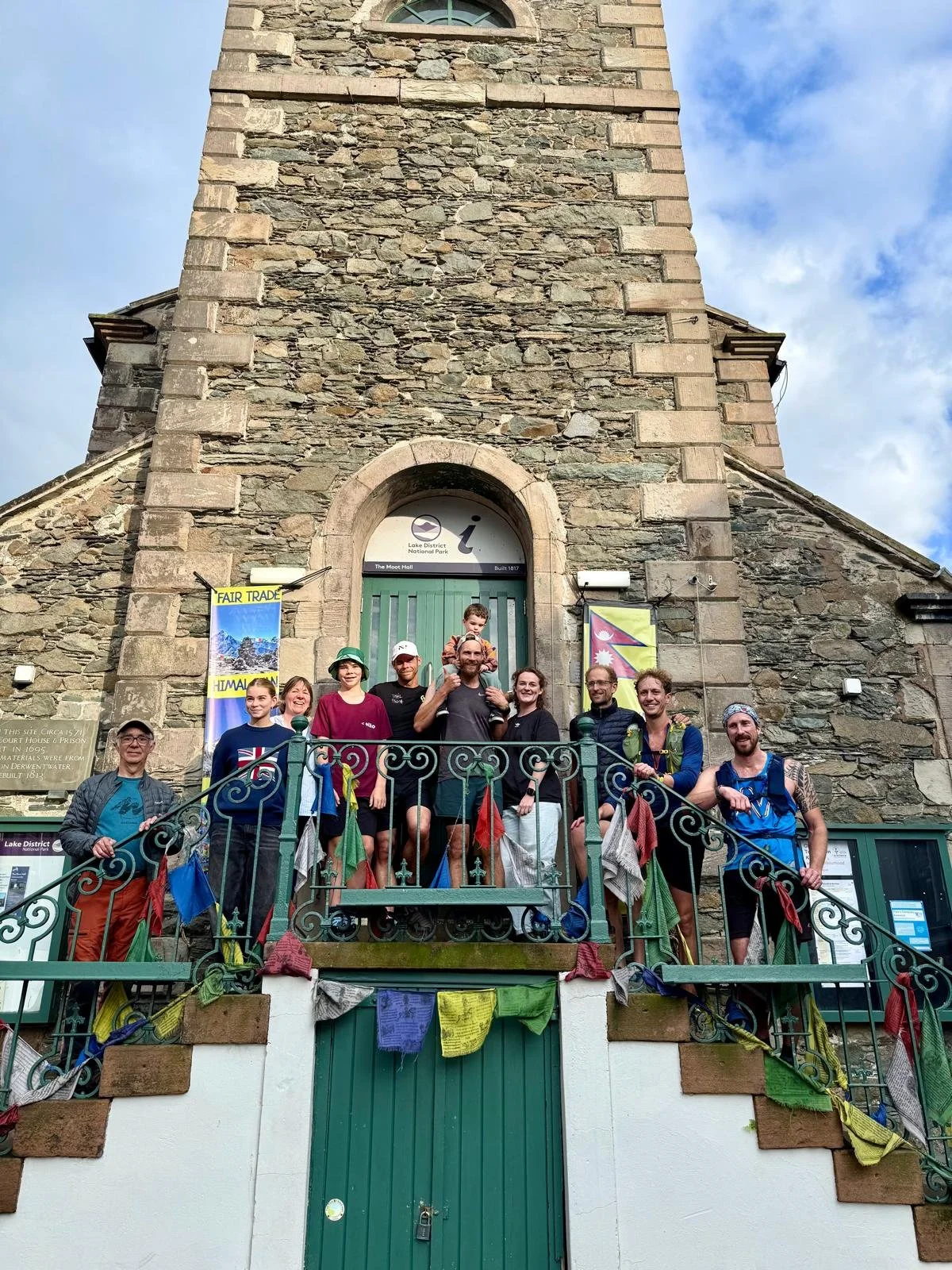The Bob Graham Round pt.3 - Do we have what it takes?
Running in the beautiful Lake District, UK
The Bob Graham Round has continued to capture the imagination. Even after bad luck, setbacks and uncertainty, the appeal of the round has remained strong.
We are getting to know the area better and better, although navigation always remains difficult, especially in bad weather.
We have had a good year of training with few setbacks.
Once the ‘workout weariness subsides, peak performance levels will restore.
The trip is booked, the last quiet training session to the top of Scafell Pike is scheduled, and we have managed to assemble a full team at the last minute.
Will luck be on our side this time? Will the weather gods be kind to us? Will our accompanying runners arrive on time? And will we make it back to Keswick in less than 24 hours, over difficult terrain, tough climbs and steep descents?
Friday 18th of July 2025, 19.59h - Moot Hall, Keswick
It's a quiet summer evening, everyone is standing around calmly and relaxed. But beneath the surface, tension is beginning to bubble up, an exciting mix of curiosity, focus and alertness.
Compared with two years ago, this time we decided to swap the night-time start time for eight o'clock in the evening. After a day of enforced rest, some breathing exercises and the final mental preparations, we took the time to go over the entire logistical organisation once again, review our plans and schedule and check the weather forecast for the 200th time.
Thirty seconds to go, I hear Andy shout. Together with Sam, I climb the steps of Moot Hall. 10, 9, 8...
It's like New Year's Eve...
The many familiar faces in the square count us down, we touch the door and we're off. On our way to a new adventure. A new attempt to complete The Bob Graham Round and hopefully be back in Keswick before the clock strikes 8 p.m. on Saturday evening.
What happened before this
Another summit ticked off
For the full story, check my Pt.1/Pt.2 blog here:
https://www.bemoreactive.fit/blog/the-bob/eng
My hamstring injury healed fairly quickly. A few weeks later, while on holiday, I already enjoyed running up and down the metres-high Dune de Pilat.
Sam, however, needed a little more time to recover. The renovations continued, even on one leg, and he was finally able to move into the newly renovated house with his family at the end of the summer.
The perseverance needed to complete a Bob Graham round now came in handy for his full rehabilitation. Gradually, there was improvement, limping turned into walking, and walking turned into running again.
In the spring of 2024, it was wisely decided to postpone the next attempt for another year in order to regain full strength, catch up on years of sleep deprivation, and prepare ourselves optimally.
May 2025, back to Cumbria
When we as “lowlanders” want to gain altitude and train uphill and downhill running , we are usually forced to find creative solutions (I can recommend a few “fun” ones ;), endless “hill repeats” or boring “stair master” sessions with the view of a white wall. We could also drive to the Vosges, the Black Forest or the Alps. But the best training is, of course, on the terrain itself.
In addition to running up and down, you become familiar with the environment, you can touch the rough rocks, smell the weather conditions, feel the history and test your feet and ankles at every conceivable angle.
Running sessions on the route itself were mapped out. Sections that were new to Sam and parts of the route where we needed more confidence. The combination of warm temperatures, the training sessions of the past few weeks, the long car journey the day before and getting reacquainted with the terrain made day 1 quite a challenge to digest.
With barely a third of the total Bob Graham round distance and “only” 3,000 metres of elevation gain, we arrived back at our tent that evening dehydrated and with empty legs. What a celebration :)
Fortunately, we were able to stay in bed a little longer the next day, as an evening session was on the programme. A route with the descent of the infamous Blencathra mountain as its highlight.
Due to the beautiful, dry weather (with a fantastic sunset on top of Skiddaw), we opted for the more technical Halls Fell route rather than the “safer” Dodick Fells descent, where things went wrong for Sam two years ago. We took our time to explore the route, in the dark by now, and build confidence in the various options for completing the descent successfully.
After some fun, challenging scrambling, we made it safely back down. And even though we didn't revisit the scene of the accident, the descent still felt like a victory. A small victory, because the big test is yet to come, exactly two months later, during our new attempt to follow in the footsteps of Bob Graham and many others.
At first, we considered aiming for an extended round with three additional peaks, which would bring the total to 45 mountain tops and better match my 45 years of age, but after some exploration, we wisely decided to stick to the essentials and thus give our attempt the best chance of success.
For our third day of training in the Lake District and to torture our tired legs a little bit more, we had planned some extra climbs, ending with a dip in the beautiful Lake Buttermere.
Bring it on!
Week after week, I feel myself getting stronger. The trip to England gave me confidence, and also mentally I was gradually feeling ready to give it my best shot , to push through and hopefully enjoy myself along the way.
But in addition to unyielding perseverance, iron willpower, a love of nature, passion for the sport and humble respect for the local history and tradition of Fell running, weeks and months of planning are also required.
Fortunately, we could once again rely on the help of my good friend Jamie, but this time it proved much more difficult to get enough runners together.
Runners with knowledge of the terrain, runners with passion and grit, runners with Bob Graham experience.
After all, for a successful Bob Graham round, you need witnesses who accurately record the time when you, as a runner, touch each peak (42 in total) with your hand or foot. For convenience, you divide the entire route (106 km and more than 8000m of elevation gain) into five parts or five “legs”, which are neatly defined by a road crossing where your team can set up an aid station with refreshments. So you look for experienced “adventurers” who will accompany you throughout an entire leg.
Just in the nick of time, we managed to put together a top team: 7 people ‘on ground’ for supplies and logistics and 7 runners along the way. The absolute minimum, but if nothing goes wrong, it will be just enough to get us through.
18th of July 2025, 20h - Leg 1 Keswick - Threlkeld
Sunset on Skiddaw
Off we go, no inflatable starting arch, no starting shot or large field of participants (although there is another candidate, John, who, like us, is also leaving at 8 p.m.) but family and friends cheering us on.
Andy and Ry (my name is Ry and Ry would finish second a week later in the famous Lakeland 100-mile race) are also ready, our accompanying runners for leg 1.
We set off on a new adventure, a long journey over mountains and through valleys, with stormy weather forecasts, the night and Blencathra ahead of us.
We can once again count ourselves lucky to have two fantastic guys with us. Andy, who has already led several Bob Graham candidates to success, and Ry, whom we coincidentally met a few days earlier on our way with Oskar to the top of Stafell Pike.
Two runners with tons of experience who also happen to be great company.
The first part goes smoothly, and once again we witness a beautiful sunset once we reach our first summit, Skiddaw. Great Calva follows quickly, only 40 mountains to go :)
When daylight has completely disappeared, it is Blencathra's turn. After some consideration, we agree to descend via Halls Fell in complete darkness.
The pace slows down and we roll up our sleeves so we can use our hands to support our feet to scramble down the steeper sections.
With Ry's experience leading the way and Andy's helpful tips, it only takes us about half an hour to make it back down. Sam has now officially gone further than he did two years ago and this is celebrated with cheers and high fives.
The confidence in our guides, the recce two months ago and the relaxed but alert atmosphere made this descent a highlight of our journey.
Right on schedule and still fresh in mind and body, we reached our first aid station where Carrie was waiting for us together with Simon and Andrew, our new guides.
Oskar and Margo were also on duty and, as seasoned crew members, they fulfilled their important role with flying colours. Seven minutes later, once again supplied with drinks and food, a fresh T-shirt and eager for more Fells, we were ready for part 2.
18th of July 2025, 23.42h - Leg 2 Threlkeld - Dunmail raise
Touch every top with your hand or foot
Back on the road with one of the many Simons (see previous blog), always nice to catch up again. Changing runners always brings a pleasant distraction. In addition to being an enormous physical and mental challenge, the Bob Graham round is also a very social event where everyone is always ready to assist you, carry extra water, open the gates of the sheep pasture and remind you that it's time to eat again.
It's a fantastic way to meet new people who share your enthusiasm for nature and your passion for running, exercise, and physical and mental challenges.
Sam: Andrew, have you done the Bob Graham Round before?
Andrew: Yes, but as part of a triathlon.
Ken: …?!
Leg 2, together with Leg 5, is considered the “most runnable” part of the circuit. That is also why we chose to complete this part in the dark.
Step by step, we count ourselves lucky that it has remained dry so far. The moon is hidden behind a few thin clouds, but I can still see its reflection in one of the numerous lakes. It's a bit early for hallucinations, so to be on the safe side, I ask the others if they have seen it too.
We remain well on schedule, ticking off peak after peak. And even though we have climbed around 2,500 metres, our legs are not showing too many signs of fatigue.
Eating, on the other hand, becomes more difficult after midnight. You can't get used to eating night-time snacks every 45 minutes, and your stomach starts to make itself heard. For me, it wasn't too bad. With small bites and liquid food, I was able to control the stomach cramps fairly well.
Sam began to suffer more and more, and getting enough food became increasingly difficult. When you burn around 600 calories per hour, it is very important to keep replenishing your energy reserves. But when your body is rebelling, it is incredibly difficult and also takes energy to deal with. Fortunately, as humans, we have some reserves to draw on.
Mountain peaks with heroic names such as Clough Head, Helvellyn and Raise were alternated with softer-sounding names such as Nethermost Pike and Dollywaggon Pike.
But don't underestimate them; to complete leg 2 successfully, Fairfield must first be conquered.
On one side, it looks soft and fluffy, covered with grass, but on our side, you feel like you're in the Alps. Loose stones, rocks and steep climbs, and when you finally reach the top, you still have to run a little further to reach the actual summit. What a nice surprise.
Our 2nd aid station at Dunmail Raise
We have been on route for over 8 hours when we successfully complete leg 2.
A new day is dawning on the horizon and our skilled supply team is ready and waiting. Kate and Hanna have sacrificed their sleep to provide us with the necessary snacks, drinks and encouragement once again.
With sleep still in his eyes, our friend Jamie was ready to take over from his brother Simon and Andrew, who had guided us fantastically through the night.
19th of July 2025, 4.32h - Leg 3 Dunmail raise - Wasdale
Without the need of head torches, we start the steep climb up Steel Fell with a little too much enthusiasm. Straight up, a real calf burner.
Leg 3 is the longest, most varied part of the route. Challenging but also beautiful. away from civilization. From bogs and marshy areas to rocky sections reminiscent of high mountains.
Unfortunately, Sam's stomach ache did not improve and it became increasingly difficult to replenish his depleted energy.
‘Don't trip now,’ Jamie said with a smile. When the terrain levelled out after the climb, I was reminded that, two years ago, it was also over and out for me here because of that nasty muscle tear.
On the one hand, I was glad that I was still much fresher mentally and physically than I had been then, but on the other hand, walking through the night had now caused my first serious dip in energy.
With Jamie on top of Scafell Pike
Maybe I had climbed too fast, or maybe I hadn't eaten enough? The energy dip hit Sam even harder, and for the first time, time was passing faster than the distance we had planned to cover.
By opting for a 22.5-hour schedule, we had built in some buffer time for ourselves.
But even so, it's a bit of a mental blow when you realise that you still have more than half of the route ahead of you.
Thanks to Jamie's experience in the field, his own successful round, his previous involvement in other successful Bob Graham rounds, and his numerous adventurous and entertaining stories, we eventually found a fairly good pace, which meant that we were only about fifteen minutes behind our target time.
Lords Rake - From Scafell Pike to Scafell
Running, walking, step by step, climbing, descending, staying focused on the ground, this is what we are trained for! Still, it remains difficult to keep up the energy.
Concentration and even digesting the small snacks also took some energy. Energy that you do get back, at least partially, when you keep eating. But energy that Sam lacked because keeping eating proved to be an impossible task.
But when we arrived at Wasdale 6 hours and 40 minutes after leaving Dunmail Raise, Sam had had enough.
Exhausted, with stomach cramps and completely drained, he took a seat in Peter's camper and mentioned giving up for the first time. Not only because he felt unwell, but mainly because he didn't want to jeopardise my chances of success.
With Peter, whom I also know from my trip to Nepal 10 years ago, I couldn't have wished for a better team member for the Wasdale stop.
With years of experience as a guide and coach, he knows better than anyone when it's really time to give up or when someone still has a little spark of energy left that can be rekindled. Ian, who was taking over from Jamie, also has extensive experience, both as a runner himself and in assisting and guiding Bob Graham runners, and together they were able to convince Sam to continue. After all, we were still well on track to reach Keswick within 24 hours.
19th of July 2025, 11.15h - Leg 4 Wasdale - Honister
Run, walk, scramble
Wasdale is sometimes referred to as “The Bob Graham graveyard” because numerous attempts have come to a premature end there.
I knew this in advance and, for me personally, the climb out of Wasdale, still to come, is the most difficult and toughest climb of the entire route. A large part of my mental preparation therefore consisted of visualising and experiencing in advance the refreshment stop in Wasdale and the gruelling climb to the top of Yewbarrow.
By thinking about the muscle pain, negative thoughts and fatigue in advance, I was able to put my condition and the situation at that moment into perspective. I had decided to look forward to the climb instead of dreading it, and it turned out to help. Mentally, that is; physically, it remained extremely tough and seemed to go on forever.
We also completed leg 4 during our training week in May. I suffered greatly from dehydration and exhaustion at the time. That blurred vision and those worn-out legs turned out to be very good preparation, because compared to then, I actually felt much better today. Once we finally reached the summit, I was convinced that, barring any accidents, I would make it to Keswick. Whether or not it would be within the 24 hours we had set ourselves, the most important thing for me at that moment was to finish together.
My slightly euphoric mood stood in stark contrast to Sam's miserable feeling.
Sam: I started part 4 and then had a miserably long climb. At the top, I was really done, and I saw Ken's chances of finishing within the time limit go up in smoke because of me. But according to Peter and Ian stopping was still out of the question. Giving up is not allowed here!
Even though I tried to say, “I really can't go on, too many cramps. I'm exhausted, I can't move forward at all”. The response I got was, “you still have plenty of time” and “you haven't thrown up - no problem” 🥴
So I just put one foot in front of the other and after a while I resigned myself to the situation. I am expected to just keep going until I drop dead.
Miraculously, this seemed to help, and gradually the tension eased and my energy began to flow again. The smiling Herdwick sheep standing on the side of the path in large numbers proved to be a source of inspiration and just the boost I needed.
Just before the descent to Honister, the end of part 4, I knew I would make it to Keswick. I sent Ian ahead with Ken. I won't make it in under 24 hours, but Ken might.
But with the pressure off, my running legs suddenly returned and just 5 minutes after Ken, I reached our supply station where our supporters were waiting in large numbers.
It was like a Formula 1 pit stop, and after a few pieces of watermelon that Ken apparently left, I was already at the foot of the next mountain. I finally found my 5926th breath and, together with Jamie, I gradually closed in on Ken, who had also left Honister with Neil's help.
19th of July 2025, 16.43h - Leg 4 Honister - Keswick
Robinson, summit 42
Arriving in Honister and greeted with loud cheers after running for more than 20 hours, it was a wonderful reunion with family and friends.
And they had watermelon, what a treat. Although from a distance it looked like we were having a party at the finish line, I didn't have much time to sit down and enjoy my watermelon. Neil and Jamie were ready for the last stretch, come on, you can do it!
I had just started the last long climb when I saw Sam appear behind me, at a pace I hadn't seen from him in the last 10 hours.
Sam kept going strong and little by little he gained ground on me so we could reach the top of Robinson, mountain peak 42, together. Just a quick photo pose and then on we went.
First, we had to survive the long descent without any accidents and then another eight kilometres on paved, sloping roads back to Keswick.
With 6 kilometres to go, we passed our holiday cottage. Oskar and Simon joined us and together we ran towards the finish.
On the square in front of the Moot Hall, life goes on as usual on Saturday evening, although most people spontaneously start applauding when they see two worn out runners sprinting towards the famous door of the Moot Hall.
Just be careful not to get run over, cross the square, climb the steps, and together we touch the same green door that 23 hours and 29 minutes ago symbolised the start of our journey.
19th of July 2025, 19.23h - Keswick - Moot Hall
At moot Hall, Keswick with part of our top team
We did it!
Almost everyone who helped us along the way or during the years of preparation was there.
Unfortunately, Jane couldn't be there due to the serious setback she suffered earlier this year, but Dave was there. From the very beginning, he inspired us with heroic stories, tales and anecdotes. Together with Jane, he was always there to welcome us, provide us with accommodation and feed us delicious food during our trips to the English Lake District.
Our friend Guy gave us a small badge with “Fell Runner” written on it.
Like just under 3,000 others and only a few Belgians, we now belong to the Bob Graham club and can finally call ourselves weathered Fell Runners.
We did it!
The next challenge was already waiting for us. Downing a pint of beer.
But even now, we weren't alone.
Our loyal and indispensable team that showed up at the finish line had also earned a celebratory drink, and after many years of dreaming, planning, misfortune, trial and error, we could finally celebrate our success.
Just for a moment, because I was already looking forward to that warm bath and a soft bed.
In the end, it stayed dry all day, with little wind and mild temperatures. Ideal conditions for running. And even though you can't control the weather, good preparation will certainly increase your chances of success.
If you want to try your luck, I'd be happy to help you to get started with advice and, if necessary, practical assistance. I know better than anyone how difficult it can be to get a team together with enough runners. Sam and I are looking forward to sharing our experience sooner or later and becoming part of your expedition.
This is what the internet says about the Bob Graham Round:
Completing the Bob Graham Round requires a rare combination of physical endurance, mental fortitude, strategic thinking, and a deep connection to the fells. It’s more than just a run; it’s a personal trial against time, terrain, and oneself. Here's a breakdown of the character traits needed:
1. Unyielding Determination
The Bob Graham Round is 66 miles over 42 Lake District peaks, typically completed within 24 hours.
The sheer scale demands a deep well of grit—a refusal to quit, even when exhausted, cold, or in pain.
2. Mental Toughness
Runners face long hours in the dark, often in solitude or silence.
Navigating fatigue, hallucinations, weather changes, and relentless climbs requires calm under pressure and a steel-trap mind.
3. Humility and Respect for Nature
The Lake District is beautiful but unforgiving.
Knowing when to push and when to hold back—respecting the terrain and the weather—is vital for survival, not just success.
4. Planning and Discipline
Success isn't just in the legs—navigation skills, split timing, nutrition strategy, and pacing are essential.
Training for the BGR involves months (often years) of preparation and self-discipline.
5. Self-Reliance and Team Spirit
While the Round can be a solo feat, most completions rely on a team of pacers and supporters.
Balancing independence with trust in your support crew is crucial—being both resilient and gracious.
6. Passion for the Fells
The Bob Graham Round isn’t a commercial race. There are no medals, no prize money.
What drives most is a love of wild places, tradition, and personal challenge.
In essence, someone who completes the Bob Graham Round isn't just an athlete. They are a disciplined adventurer, a weathered optimist, and someone who finds meaning in moving fast through mountains with purpose and pride.

